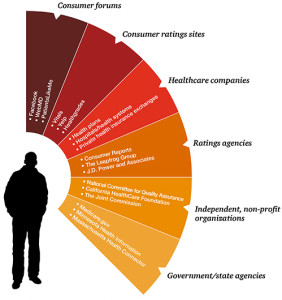
Patient satisfaction survey scores have begun to directly impact Medicare payment for health providers. Health plan members are morphing into health consumers spending “real money” in high-deductible health plans. Newly-diagnosed patients with chronic conditions look online for information to sort out whether a generic drug is equivalent to a branded Rx that costs five-times the out-of-pocket cost of the cheaper substitute.
While health care report cards have been around for many years, consumers’ need to get their arms around relevant and accessible information on quality and value is driving a new market for a Yelp, Travelocity, or Zagat in health care. Scoring healthcare: Navigating customer experience ratings from PwC’s Health Research Institute assesses the situation.
The graphic illustrates the fact that consumers have a broad range of sources for health ratings, from consumer crowdsourced data generated in forums like PatientsLikeMe and WebMD; consumer ratings sites such as Yelp, HealthGrades, and Vitals; ratings agencies including J.D. Power & Associates; independent non-profits like the California HealthCare Foundation; public sector agencies including many state health ratings projects; and from health care companies themselves.
Notwithstanding the presence of these many ratings sources, consumers haven’t flocked to them. One reason is that each offers their own rating methodology, and these inconsistencies across different ratings systems often create confusion leaving consumers scratching their heads. The alphabet soup of ratings standards includes HCAHPS, HEDIS, NCQA, Leapfrog Group, JCAHO, and Medicare Quality Star, among others. Consumer Reports uses moons and half moons for hospitals and drug stores, but a 1 through 4 number score for medical groups (low to high performing) and 5 through 1 for health plans (ranging better to worse). Vitals ranks on 4 stars; Yelp ranks on 5.
This is an over-abundance of ratings. But is it an embarrassment of riches? Not really. As Peggy O’Kane, head of the National Committee for Quality Assurance, said, “Healthcare ratings are still in a formative stage. Most are not yet at a point of sophistication to drive consumers to high-performing players.”
Different aged consumers prefer different ratings sources. For older consumers 65+, government and Consumer Reports rank highly. For consumers 18-24, social media sites are preferred.
PwC’s 2012 consumer survey found that 31% of consumers read doctor ratings, 28% hospital ratings, 16% insurance company ratings, 15% drug and medical device ratings, and 12% pharmacy ratings.
Health Populi’s Hot Points: It is early days for consumer ratings in health care. But barriers include “TMI” — too much information; social relationships with friends, doctors, and advisors, where personal relationships trump ratings systems, according to Dan Ariely, the behavioral economist; and, consumers’ lack of feeling like they have a choice in their health care decisions, a legacy from a more paternalistic, employer-based health system that’s selected a short menu of options from which people have traditionally picked.
The U.S. health consumer is the New American Picker: she’s looking for health goods and services — health insurance, prescription drugs, the best hip implant for her mother — and she needs a roadmap to the marketplace for each of these situations. Health insurance exchange/marketplace navigators…Consumer Reports Best Buy Drugs…and patient communities bringing together arthritis sufferers…all of these will be useful connectors for these health pickers (which includes all of us). Picking — shopping — is another aspect of health engagement.
PwC suggests, rightly, that the disengaged health consumer ultimately costs more than the engaged. We learned this through Judith Hibbard’s excellent research on patient activation published in the February 2013 issue of Health Affairs. Successful patient engagement will include health consumers accessing trusted health rating information. Health companies — insurers, hospitals, pharmacies, drug and medical device companies, and doctors, all — are on notice. Both payment and market share will be increasingly earned based on how consumers feel about you. Welcome to the Zagat-Yelp-TripAdvisor era of health care. This is the new retail health.




 I'm in amazing company here with other #digitalhealth innovators, thinkers and doers. Thank you to Cristian Cortez Fernandez and Zallud for this recognition; I'm grateful.
I'm in amazing company here with other #digitalhealth innovators, thinkers and doers. Thank you to Cristian Cortez Fernandez and Zallud for this recognition; I'm grateful. Jane was named as a member of the AHIP 2024 Advisory Board, joining some valued colleagues to prepare for the challenges and opportunities facing health plans, systems, and other industry stakeholders.
Jane was named as a member of the AHIP 2024 Advisory Board, joining some valued colleagues to prepare for the challenges and opportunities facing health plans, systems, and other industry stakeholders.  Join Jane at AHIP's annual meeting in Las Vegas: I'll be speaking, moderating a panel, and providing thought leadership on health consumers and bolstering equity, empowerment, and self-care.
Join Jane at AHIP's annual meeting in Las Vegas: I'll be speaking, moderating a panel, and providing thought leadership on health consumers and bolstering equity, empowerment, and self-care.